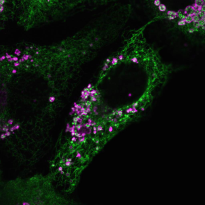News
RTN3 identified as novel ER-phagy receptor
 August 2017. The endoplasmic reticulum (ER) is the cell’s largest and probably most versatile organelle. It consists of extended membrane structures, which are constantly remodeled to ensure functionality in all cellular states. Degradation of the ER is mediated by a specialized form of selective autophagy (ER-phagy), a process which is until now not very well understood. An international team around Ivan Dikic has identified Reticulon 3 (the full-length form of RTN3) as a selective receptor which specifically triggers fragmentation of ER tubules and their delivery to lysosomes. The process requires the core autophagy machinery but is independent of FAM134B, the first ER-phagy receptor previously identified by Dikic’s group. FAM134B is responsible for targeting ER sheets rather than ER tubules.
August 2017. The endoplasmic reticulum (ER) is the cell’s largest and probably most versatile organelle. It consists of extended membrane structures, which are constantly remodeled to ensure functionality in all cellular states. Degradation of the ER is mediated by a specialized form of selective autophagy (ER-phagy), a process which is until now not very well understood. An international team around Ivan Dikic has identified Reticulon 3 (the full-length form of RTN3) as a selective receptor which specifically triggers fragmentation of ER tubules and their delivery to lysosomes. The process requires the core autophagy machinery but is independent of FAM134B, the first ER-phagy receptor previously identified by Dikic’s group. FAM134B is responsible for targeting ER sheets rather than ER tubules.
The scientists were surprised to discover that the full length RTN3 contains six of the so called LIR motifs that are essential for the function of a autophagy receptor. Normally, a single LIR motif is sufficient. Most likely, the high amount of LIR motifs leads to a positive amplification loop. The experiments also enabled a broader view on different roles of the RTN protein family, highlighting the importance of discriminating between isoforms which display highly specialized and unique functions. The results have recently been in the journal eLife (Link).
Contact:
Ivan Dikic, Institute of Biochemistry II (press contact Kerstin Koch, tel. +49 (0)69 6301 84250, k.koch@em.uni-frankfurt.de)
Publication:
Grumati P, Morozzi G, Holper S, Mari M, Harwardt MI, Yan R, Müller S, Reggiori F, Heilemann M, Dikic I (2017) Full length RTN3 regulates turnover of tubular endoplasmic reticulum via selective autophagy. eLife 6. http://dx.doi.org/10.7554/eLife.25555
Cluster of Excellence Macromolecular Complexes, Frankfurt am Main

